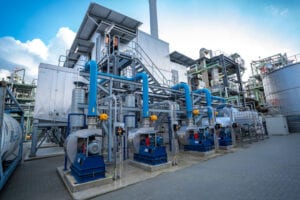
Nitrous oxide reduction unit at the caprolactam plant in Antwerp, Belgium (Source: Lanxess)
Last month, Lanxess AG (Cologne, Germany; www.lanxess.com) inaugurated a new plant in Lillo/Antwerp, Belgium to reduce the nitrous oxide emissions that are generated during the production of caprolactam. The €10-million investment breaks down approximately 500 metric tons (m.t.) of N2O per year, which is equivalent to the climate impact of 150,000 m.t./yr of CO2 (CO2e). A second plant to reduce an additional 300,000 m.t./yr of CO2e is planned to start up in 2023.
The new plant uses a two-step process that was developed with cooperation partner CTP Chemisch Thermische Prozesstechnik GmbH (CTP; Graz, Austria; https://ctp-airpollutioncontrol.com). In the first step, N2O is broken down into N2 and O2 using a regenerative thermal oxidation (RTO) process at 1,000°C. In the second step, the oxides of nitrogen (NOx) are reacted with ammonia in a selective catalytic reduction (SCR) unit operating at 250–450°C to produce N2 and water. The combination has an overall 90% abatement efficiency.
The plant has a high thermal efficiency, thanks to the use of a specially developed ceramic heat exchanger for heat integration. These heat exchangers capture and store the heat used in the thermal oxidation process and generated during the breakdown of N2O and NOx. When the heat exchangers have stored the heat from the clean gas, the process flow changes direction and the heat exchangers now preheat the incoming exhaust gas. This change of direction then takes place recurrently. This means that significantly less external energy has to be supplied to keep the process running, says the company.
In addition to the Antwerp plant, the Group is currently implementing further climate-protection projects with the aim of becoming climate neutral by 2040.